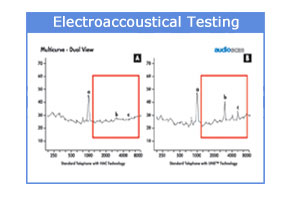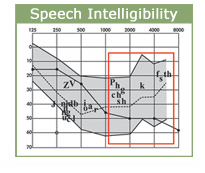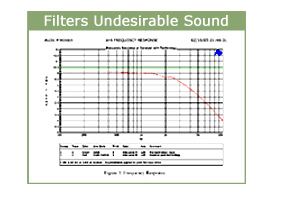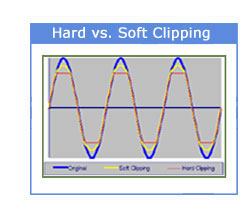|
Solitude
with Linx Audio Noise Cancelling Headset
Now with new Linx
audio sound processing and the same price as the Solitude 2
headphones they replace
The original Solitude was designated 2005
Best Travel Product Winner by Reader Voting |
|
The new Linx audio equipped Solitude headset is
identical to the previously reviewed Solitude II headset in
almost all visible respects, other than for the addition of
a Linx logo on the side.
Part 14 of a series on noise
reducing headphones -
click for Parts One
Two Three
Four Five
Six
Seven
Eight
Nine
Ten
Eleven
Twelve
Thirteen
Fourteen |
We've previously reviewed and
very much liked the first two models in the Plane Quiet Solitude
series of noise reducing headphones.
They've now added an
interesting and innovative new feature to the headphones - Linx
audio processing, claimed to improve the sound quality, particularly for
people with some hearing loss.
Unfortunately, we find the
results of the Linx processing almost impossible to detect (we
were told that was perhaps because we had no hearing loss!) and
completely can't understand the underlying theory of what the
Linx processing is supposed to do, why, or how.
The headphones don't have a
defeat switch to turn off the Linx processing. The
good news is the Linx processing does not appear to harm the
quality of the audio, but neither does it seem
to appreciably improve it. Fortunately you're not being
charged any extra for this feature, so perhaps the value of the
Linx processing becomes a moot (or should I say mute) point.
With a list price of $200, the
Solitude with Linx noise canceling headphones are $100 below
their arch competitor, the Bose Quiet Comfort 2. Few
people will see any extra value in the $100 more expensive Bose
product, and most will choose the Solitude accordingly.
Executive Summary
The new Solitude headphones
with Linx sound processing are an interesting new product from
the Plane Quiet Group. In addition to the Linx audio,
there have been some other subtle tweaks to improve their
performance over the Solitude 2 headphones they replace.
-
A new material goes into the
earpads, giving a better and more comfortable fit between
the headphones and the side of your head, and also
increasing the passive noise blocking performance of the
headphones.
-
Slightly higher impedance
improves audio fidelity.
-
The noise detecting
microphones have been slightly moved, and the noise
cancelling algorithm slightly tweaked so as to make a small
improvement to the active noise cancelling performance.
Some listeners may
feel the Linx audio makes the sound 'nicer', but whether that is
due to a placebo effect or to something more tangible is
uncertain. Furthermore, even if there is a change in tonal
quality, are you
wishing to listen to 'nice' sound or are you wishing to listen
to 'pure' sound exactly as you'd hear in real life?
Fortunately the Linx
processing is very subtle, so the question isn't a burning one
that really needs much of an answer.
I've tried to avoid too much
repetition between this review and the
Solitude II review,
with this review here concentrating mainly on the differences
between the two headphones. So to get a complete understanding of all issues, you should read both reviews.
The Solitude with Linx Active Noise
Cancelling Headset - what you get
Apart from the enhancements
listed above, everything you get with the Linx version Solitude noise canceling headphones is identical to
what you get with the standard Solitude II headphones and so you
can read
that section of the Solitude II review without needing to
make any changes.
Indeed, everything is so
identical that there's almost no reference to or explanation of
the Linx audio processing, other than a single short sentence on
the outside of the box which reads
The patented Linx Audio system transmits a more efficient
sound to the inner ear, enhancing sound quality, improving
speech intelligibility and increasing perceived loudness
without increasing the volume control of the audio device.
One would have hoped for a
more detailed description, perhaps in the manual, but the manual
is the standard Solitude manual and makes no reference at all to
the Linx feature.
Headphones Description
The new Linx equipped
headphones are almost completely identical, from the outside, to
the current Solitude II non-Linx headphones.
The only
visible difference is a subtle logo saying 'Linx Audio' on the
ear cups. Dimensionally they seem identical, although
there's an imperceptible half ounce extra in weight for the Linx
headphones - 8.6 oz instead of 8.2 oz, presumably reflecting the
weight of the Linx components that were added.
Noise Cancelling Functionality
The noise cancelling
abilities of the Linx type Solitudes seems to be very similar to
that of the regular Solitude II headphones, with possibly a very
small degree of improvement.
There is one noticeable
improvement - there is slightly less audio hiss with the Linx
headphones. This is slightly surprising - I'd have thought
the extra electronics would have added to the hiss level, but -
at least with the test set I had - the hiss level was slightly
less, and after further research, it appears that the Linx
feature doesn't involve much active electronics, but rather uses
passive components (magnetic cores).
Comfort and Convenience
The new Linx version of the
Solitude headphones have an upgraded (ie softer) material used
in the earcup surrounds. This not only makes the fit more
comfortable but it also more effectively seals the headphone to
your ear, providing slightly better passive sound blocking.
Other than that, there are
no differences between the regular Solitude headphones and the
Linx version.
The Linx Audio Feature
And now for the part you
(and I) have been eagerly waiting for. The Linx Audio.
What it is claimed to do
The Linx audio is claimed to
offer a range of benefits. According to the developer's
website
Linx alters the the audio signal carrying a more efficient
sound to the inner ear, enhancing sound quality, improving
speech intelligibility and increasing perceived loudness
without increasing the volume control of the audio device.
At
identical volume levels, products with LINX will sound
richer, louder and clearer, providing access to everyday
audio and communication products for people with hearing
loss, and providing a means [f]or other listeners to "Turn
it Down™".
The website goes on to claim
the Linx technology filters undesirable sound, soft clips
distortion, reduces electromagnetic interference, and increases
loudness without increasing volume.
 The
Linx technology is apparently based primarily on a small
magnetic core with wire around it that the audio signal passes
through before then being transferred on to the headphone
speaker (ie it is in series with the headphones). The
Linx technology is apparently based primarily on a small
magnetic core with wire around it that the audio signal passes
through before then being transferred on to the headphone
speaker (ie it is in series with the headphones).
This would seem to be a
derivative of a regular audio 'choke' - a device which selectively impedes the
flow of signal based on the frequency of the signal passing
through.
The website offers some
unexplained and fuzzy miniature graphs to support its claims; I
don't really understand what they are or what their significance
is, but here they are, directly copied for your similar
edification :




Formal laboratory testing
The folks at Plane Quiet
kindly gave permission to offer to you a laboratory analysis of the Linx technology -
click here for the pdf of this report.
However, this report doesn't
fully evaluate all aspects of the Linx technology and its
claims. It starts off by referring to claims of the
validity of Linx but never really tests for these claims,
limiting itself to reporting on any observed differences as seen
through their test equipment, rather than tangible differences
that people can hear. This is of course partially
unavoidable in a scientific objective test, but still somewhat
disappointing.
Page 11 of the report shows
the extra harmonics generated by the Linx audio at normal
listening volumes. These extra harmonics appear to be
small rather than substantial. Page 12 shows the extra
harmonics when the Linx audio is played at 'maximum peak levels'
- although there are clearly more harmonics at the too-high
level, who is going to want to play music too loud in order to
hear these effects?
This also conflicts with one
of the developer's claims - you can turn down the volume
lower than normal with the Linx technology. Indeed, based
on these two tests, it may be that the quieter the sound level,
the less perceptible the Linx technology, quite the opposite of
what was claimed.
One interesting part of the
formal testing was a discovery that the Linx hardware adds a small amount of
extra distortion to the signal, but this extra distortion
'tricks' the ear into believing there is less rather than more
overall distortion when actually listening to music. This
effect was observed in my actual testing (see below).
The testing is silent on the
developer's claims for 'soft clipping' and reducing
electromagnetic interference, and simply accepts and repeats
without testing the claim about improved intelligibility.
Linx has won awards
To be fair to Linx, products
with the Linx technology in them have won awards at the annual
Consumer Electronic Show in both 2006 and 2007.
Obviously some people think
Linx is good. But there is no shortage of products which
win high end awards but which offer 'ordinary people' no
tangible benefit (just think about things like ridiculously
expensive audio cables and all the extravagant claims that are
made in support of them), and so the mere winning of awards does
not necessarily guarantee any real world tangible benefits.
Subjective impressions
I listened carefully to a
range of classical music sources - both solo instrument (violin
and piano) as well as orchestral and vocal pieces, using a pair
of Solitude II headphones and a pair of Solitude with Linx
headphones, both connected through a Boostaroo splitter to the
same audio source (MP3 player with 192kb sampled audio tracks).
I did the testing 'blind' so as not to know which headphones
were the Linx ones and which were the regular ones.
The difference in sound
quality was almost imperceptible. Perhaps the Linx
headphones sounded very slightly 'brighter' and 'clearer', but
also slightly less 'rich' in tone, but this difference was very
subtle and may have been my imagination.
Other people who tested the
headphones side by side also reported no major difference
in sound quality.
When listening to the
headphones with no audio source connected, the background hiss
sounded slightly less through the Linx headphones than the
regular headphones.
Overall, the differences
that I could perceive between the Linx equipped and regular
Solitude noise reducing headphones were slight and
inconsequential rather than revolutionary.
Does Linx work better for
people with hearing loss?
It was suggested that my
inability to detect an appreciable difference when using the
Linx equipped headphones may be due to my not having any
substantial hearing loss.
It is possible my hearing is
relatively good, although I'm slightly the wrong side of 50, and
so would expect to have some age related hearing loss.
But surely the better one's
hearing, the easier it is to detect changes to the sound signal?
On the other hand, there are
credible testimonials from people with severe hearing loss who
say they can notice a great difference when comparing Linx to
non-Linx headphones. I haven't met or interviewed
any of these people giving testimonials, so can only pass this
on without comment or endorsement.
Other Observations and Issues
In most other respects the Linx and non-Linx versions of the Solitude headphones seem to be
identical.
Where to Buy
These headphones are no
longer made. See our review of the
Solitude X headphones
for the latest generation of Solitude headphone technology.
Summary and Recommendation
After a couple of years of
giving Bose an increasingly intense amount of competition, the
original and enhanced Solitude II probably drew almost even with the
Bose Quiet Comfort II, especially when the $100 saving was
factored in to the equation.
The new Solitude with Linx
is now slightly better than the Solitude II it replaces, and at
the same appealing price point, further strengthening these
headphones' place as best value for people wanting a high level
of noise cancelling at a sensible price.
Related Articles, etc
|
If so, please donate to keep the website free and fund the addition of more articles like this. Any help is most appreciated - simply click below to securely send a contribution through a credit card and Paypal.
|
Originally published
1 Dec 2006, last update
21 Jul 2020
You may freely reproduce or distribute this article for noncommercial purposes as long as you give credit to me as original writer.
|

